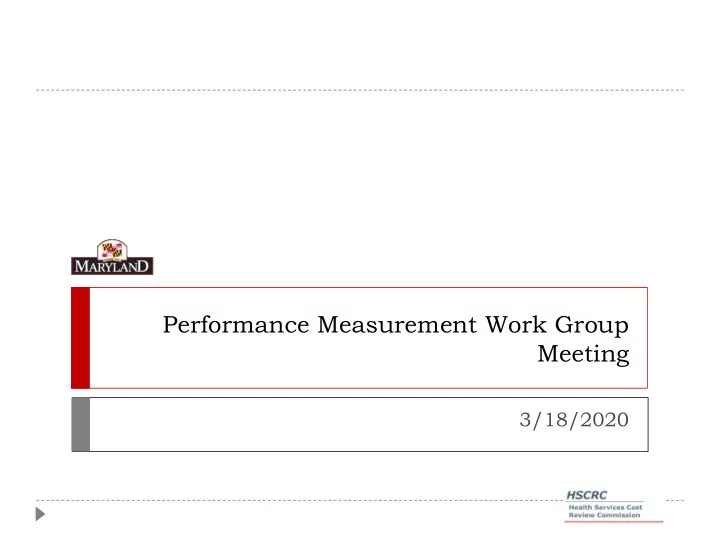

Performance Measurement Work Group Meeting 3/18/2020
Agenda 1. Welcome and introductions 2. Potentially Avoidable Utilization (PAU) a. RY 2021 Preliminary Results ◻ Report update: ◻ Out of State ◻ National Adjustment ◻ IP added ◻ RY 2021 Revenue Adjustments 2
RY2021 Performance Reporting 3
PAU Summary Report updated ▶ Reflects stakeholder comments at last PMWG ▶ PQI performance displayed for both IP and IP/OBS24+ ▶ Full Year (does not need to be annualized) ▶ Attributed Population ▶ PQI 90 Expected: Expected PQIs based on national norms applied to attributed population (age and gender) ▶ YTD Observed ▶ Attributed PQI 90 ▶ Annualized Observed ▶ Divide by months of performance and multiply by 12 to annualize ▶ Attributed population and expected values are for the full 12 months 4
PAU Summary Report (con’t) ▶ Unadjusted per capita = Annualized Observed / Population x 1000 ▶ Risk Adjusted rates = Annualized Observed / Expected x National Constant from AHRQ ▶ 12.0039 ▶ Previously, we used the statewide per capita rate to calculate the risk adjusted values. 5
Out of State Adjustment ▶ Case-mix data captures PQIs that occur in state ▶ Out of State PQIs estimated based on observed Medicare out of state PQIs (CCLF) ▶ Approximate out-of-state All-Payer PQIs via: ▶ Observed out-of-state Medicare PQIs (CCLF) ▶ Ratio of In-State All-Payer PQIs/In-State Medicare PQIs where x = OOS AllPayer PQIs (Approximated) ▶ Annualize based on months of Medicare data ▶ Increase Observed PQIs by approx. OOS AllPayer PQIs 6
PAU Performance for Hospital Scaling ▶ Avoidable Admissions ▶ Weighted combination of PQI 90 Risk adjusted rate with out of state adjustment and PDI 90 Risk adjusted rate ▶ PAU Readmissions ▶ Estimated revenue associated with non-PQI sending readmissions ▶ The average cost of an intrahospital readmission at each hospital was calculated and applied to the total number of sending 30 day readmissions to calculate the estimated readmissions revenue value. 7
RY2021 Preliminary PAU Savings Adjustment 8
RY2021 Adjustment ▶ Percent Reduction ▶ As last year, do not provide update factor inflation to PAU revenue ▶ New : Exclude dollars associated with categorical exclusions to align with Innovation policy 9
Preliminary RY2021 PAU Savings Calculation: Savings Tab Calculation of Statewide Reduction Formulas 17,695,722,212 RY20 Total Approved Permanent Revenue A RY21 Inflation Factor + Volume B 2.72% Removes categorical Total Experienced PAU $ CY 2019 C 1,862,217,148 exclusion -$50,652,306 Proposed Required Revenue Reduction $ D = B*C -0.29% Proposed Required Revenue Reduction % E=round(D/A,4) Adjusted Proposed Required Revenue F = E*A $51,317,594 Reduction Total PAU % G 10.48% Total PAU $ H=A*G $1,855,384,463 -2.77% Required Percent Reduction PAU I = F/H 10
Domains ▶ Weighting of avoidable admissions and PAU readmissions reductions based on statewide revenue values ▶ Revenue not used to calculate hospital-specific performance Table 2: Calculation of PAU PAU Revenue % PAU Required PAU Required PAU Savings Domain Weights Revenue Reduction (%) Reduction ($) Domain Weights Avoidable Admissions $807,687,806 43.37% -0.13% -$22,257,660 (PQIs and PDIs) Readmissions $1,054,529,343 56.63% -0.16% -$29,059,935 Total $1,862,217,148 100.00% -0.29% -$51,317,594 Savings % Savings $ 11
Hospital PAU Savings Tab ▶ Column E: Scales statewide avoidable admission PAU reduction of - 0.13% based on hospital’s performance compared to statewide value of 13.2 ▶ A hospital with a score of 26 around double the statewide score of 13.2, so the reduction is -0.25%, about double the statewide avoidable admission reduction ▶ Column F: Apply adjustment to permanent revenue ▶ Column G: Normalizes to ensure that Avoidable Admission reduction is equal to required reduction ▶ Same process is repeated for PAU readmissions (columns H through K) 12
Appendix. Benefits of PAU in Market Shift 13
Benefits of a PAU Service Line in Market Shift ▶ One of the principal incentives of global budgets is to reduce potentially avoidable utilization (PAU). ▶ Prevention Quality Indicators (PQIs) and Pediatric Quality Indicators (PDIs) – avoidable admissions as defined by Agency for Healthcare Research and Quality (AHRQ) ▶ Readmissions – 30 day all cause, all payer readmissions defined similarly to the RRIP program ▶ In addition to being able to increase charges as PAU declines, which offers a one time benefit to a hospital’s margin (should costs actually decline concurrently), hospitals can also permanently improve margins by reducing PAU because it is excluded from the market shift methodology. ▶ Global budget volumes are adjusted for reductions in PAU, which effectively increases corridors and further incentivizes reductions in PAU. 14
Benefits of a PAU Service Line in Market Shift (con’t) ▶ Market shift methodology includes a grouping of PQIs, PDIs, and Readmissions (PAU Service Line) to purposely omit these volumes from market shift calculation ▶ Identifying volumes as PAU within market shift allows hospitals on a permanent basis to keep 100 percent of the revenue associated with successfully reducing avoidable utilization ▶ If PAU was not defined in market shift, volumes associated with PQIs, PDIs, and Readmissions would potentially be perceived as a shift from one hospital to another, thereby eliminating the strong incentive to reduce PAU ▶ Hospitals that reduce PAU that is quantified as a shift to another hospital would lose 50% of the revenue associated with this volume, i.e. the variable costs. ▶ Hospitals that increase PAU that is quantified as a shift from another hospital would gain 50% of the revenue associated with this volume, i.e. the variable costs. 15
Benefits of a PAU Service Line in Market Shift Example 16
Next Work Group Meeting Next PMWG meeting is scheduled for Wednesday, April 15 17
Recommend
More recommend